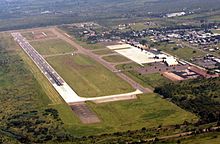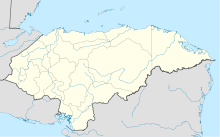- Soto Cano Air Base
-
Soto Cano Air Base 
IATA: XPL – ICAO: MHSC Summary Airport type Military Location Comayagua Elevation AMSL 628 m / 2,060 ft Coordinates 14°22′57″N 087°37′16″W / 14.3825°N 87.62111°WCoordinates: 14°22′57″N 087°37′16″W / 14.3825°N 87.62111°W Map Location in Honduras Runways Direction Length Surface m ft 17/35 2,441 8,009 Asphalt Source: DAFIF[1] Soto Cano Air Base (commonly known as Palmerola Air Base) is a Honduran military base 5 mi (8.0 km) to the south of Comayagua in Honduras. It houses between 500 - 600 US troops and is also used by the Honduran Air Force academy.[2][3] The airbase became operational in 1981, changing the old location the Honduras Air Force Academy in Toncontin, Tegucigalpa to Palmerola.[4]
The US government once used Palmerola as a base of operations to support their foreign policy objectives in the 1980s. Now the U.S. military uses Soto Cano as a launching point for its war on drugs efforts in Central America as well as humanitarian aid missions throughout Honduras and Central America.[3]
In addition to the Honduran Air Force Academy, the US military's Joint Task Force Bravo (JTF-B) is headquartered at Soto Cano.[3] JTF-B consists of Medical Element - Military Hospital, Army Forces, Air Force Forces, Joint Security Forces, and the 1st Battalion-228th Aviation Regiment (consisting of some 18 aircraft, a mix of UH-60 Black Hawk helicopters and CH-47 Chinook helicopters).
Contents
About Soto Cano and JTF-Bravo command and structure
José Enrique Soto Cano Air Base is a Honduras military installation and home of the Honduras Air Force and Honduras Air Force Academy. It is located less than 10 mi (16 km) from Comayagua (population: 33,000), and 60 mi (97 km) from the Honduras capital, Tegucigalpa. The base is about 2 × 6 mi (3.2 × 9.7 km); lies in the Comayagua Valley and is ringed by 8,000 ft (2,438 m) mountain peaks to the east and west. Soto Cano sits at an elevation of 2,062 ft (628 m) above sea level.
The American contingent at Soto Cano Air Base is designated Joint Task Force-Bravo[5] and consists of both U.S. military personnel and Honduran civilians. They work in six different major support commands including the Joint Staff, 612th Air Base Squadron, Army Forces, Joint Security Forces and Medical Element. The sixth MSC is a tenant unit also based at Soto Cano. The 1st Battalion, 228th Aviation Regiment, a U.S. Army South asset, provides aerial support for the JTF-Bravo mission. The Joint-Staff provides command and control for JTF-B.
The 612 ABS has among its functions; weather forecasting, fire protection, and maintaining a 24-hour C-5 Galaxy-capable runway. The Army Forces operate finance, personnel and airborne operations. Joint Security Forces consists of Air Force and Army force protection personnel who patrol the base and provide gate guard duty alongside their Honduran counterparts.
Health care services are performed by the Medical Element. The 1st Battalion, 228th Aviation Regiment performs a variety of airlift support missions throughout Central and South America with UH-60 Black Hawk and CH-47 Chinook helicopters. U.S. forces are guests on the base which is the home of the Honduran Air Force Academy. Soto Cano is not a U.S. installation as some media report.
Infrastructure
The Constitution of Honduras does not permit a permanent foreign presence in Honduras.[6] A "handshake" agreement between the United States and Honduras allows JTF-Bravo to remain in Honduras on a "semi-permanent" basis. This agreement, an annex to the 1954 military assistance agreement between the United States and Honduras, can be abrogated with little notice. Soto Cano lodging for U.S. personnel there consists of "hooches" and metal barracks. The hooches are temporary wooden buildings of tropical design, normally 16 × 32 ft (4.9 × 9.8 m) with screened windows and a tin roof with air conditioners and fans for cooling. Metal dormitories are more permanent structures and have air conditioning. Both contain beds and other furniture, televisions, refrigerators and microwaves.
The hooches and metal barracks have no running water. However, latrines, shower facilities and laundry rooms are centrally located to the living areas. Dayrooms, volleyball courts, barbecues and "bohios" (covered picnic areas) are also located throughout the base. All the domestic facilities, like the post office, library, dining facility, fitness center, pool and base exchange, are clustered together within a five-minute walking distance.
The apartments and dormitories would replace some of the 270 wooden hooches used for decades by permanent party personnel, but now used by permanent and temporary party personnel. Most permanent party personnel are stationed at JTF-Bravo for several months and the assignment is treated as a remote assignment, much like assignments to Republic of Korea.
Plans called for the construction to take place over the forthcoming years with all base facilities to either be new or receive major upgrades. A big improvement with new construction will be the indoor plumbing and central air conditioning in the new buildings. Currently, metal and wooden dormitories each have an air conditioning unit, but no running water. In addition, the new buildings will lessen the requirement for constant maintenance.
As of January 2008, all 44 of the apartment buildings were finished and already occupied. Additional four-unit apartment buildings, or "quads," are scheduled to be built in 2009. When construction on the dormitories would begin remains unclear.
All military personnel live on the installation; contractors live off base on the local economy. Contractors and foreign national employees are the only personnel allowed to drive personal vehicles on base and the majority of people walk or ride bicycles. Because the base is so compact, it poses no problem getting around.
Personnel assigned to Soto Cano can ride a bus that will transport them to Soto Cano from Tegucigalpa. The bus runs in conjunction with arrival and departure times.
Civil aviation
In 1990 Honduran President Rafael Leonardo Callejas decreed that commercial cargo flights were authorized to operate from Soto Cano. In 2008 President Manuel Zelaya announced that commercial flights would begin at Palmerola within a period of 60 days, after a crash at Toncontín International Airport which resulted in 5 deaths was blamed on the runway being too short at Toncontín.[7] Following an investigation into the incident, Pilot error was found to be the main cause. The military was placed in charge of building a civilian air terminal with funding from the Bolivarian Alternative for the Americas (enabled by emergency decrees). This however was cancelled after Zelaya was removed from office on June 28, 2009 in the 2009 Honduran coup d'état.[8]
References
- ^ Airport information for MHSC at World Aero Data. Data current as of October 2006.Source: DAFIF.
- ^ http://www.informationclearinghouse.info/article23123.htm
- ^ a b c http://www.globalsecurity.org/military/facility/soto-cano.htm
- ^ [1] (Spanish)
- ^ [2]
- ^ http://www.nlginternational.org/news/article.php?nid=415
- ^ En sesenta días se habilitará Palmerola
- ^ Thelma Mejía (June 2, 2009). "HONDURAS: Soldier, Sailor, Airport Builder?". Australia.TO (from IPS). http://www.australia.to/index.php?option=com_content&view=article&id=10581:honduras-soldier-sailor-airport-builder&catid=71:world-news&Itemid=201.
External links
Categories:- Buildings and structures in Honduras
- Military of Honduras
- United States Army airfields
- Military facilities of the United States in Honduras
- Airports in Honduras
Wikimedia Foundation. 2010.

